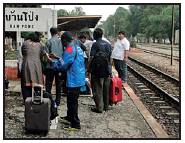South-East Asia and India
This is a collection of articles archived for the excellence of their content. |
Siam- Burma Railway

From: Aradhana Takhtani, Indian labourers, the unsung heroes behind Death Railway, December 27, 2018: The Times of India
Lonely Planet describes this historic site as the “300-m-long bridge, heavy with the history of Thailand-Burma Railway, the construction of which cost thousands of imprisoned labourers their lives.” And in a direct reference to River Kwai’s popularity as a tourist spot, it mentions the “funfare like atmosphere” on the bridge and the “sound and light show on the history of Death Railway.”
This slice of World War II has become a major tourist attraction in Thailand and there stands the bitter irony: people who build this railway by perishing in thousands during its construction, giving it its name, lie forgotten.
They were mostly Indian labourers, more than a hundred thousand in number, who constructed the railway. Thousands were forcibly picked up, while some volunteered. Having migrated from British India to work in the rubber plantations of yet another colony, Malaya, the Tamil Indians saw a journey to prosperity as the Japanese promised them three times the wages at the estates.
What awaited them though at the 415-km stretch of Siam (now Thailand) – Burma Railway was death and ignominy. Most of them lost their lives due to cholera, dysentery, neglect and malnutrition.
The year 2018 marks the 75th year of the completion of Death Railway and thousands of Indians still lie in unmarked mass graves along the railway and the campsites, forgotten by all, including the governments of India, Britain, and Japan. On the other hand, the remains of the Allied Forces POWs who also worked and died at the Death Railway were exhumed, and ceremoniously commemorated in cemeteries and monuments in Kanchanaburi.
P Chandrasekaran, chairman of the Death Railway Interest Group, Malaysia, which last week organised a special trip to retrace the journey of the labourers, said, “This was an opportune moment to rememberthe forgotten Asian victims. Indians, who formed the bulk of the 270,000-strong workforce employed by the Japanese... are reduced to a footnote in history. This must change.” “While the ordeal of the POWs is well documented and immortalised in the Hollywood flick “Bridge Over River Kwai,” a search in the public domain reveals little about the dead Indians of Malaya,” he said. And this is the reason why people like G Balakrishnan, who lost both his grandfathers to the railway, and who joined the commemoration trip, seek some recognition from the Indian government in the form of a statue.